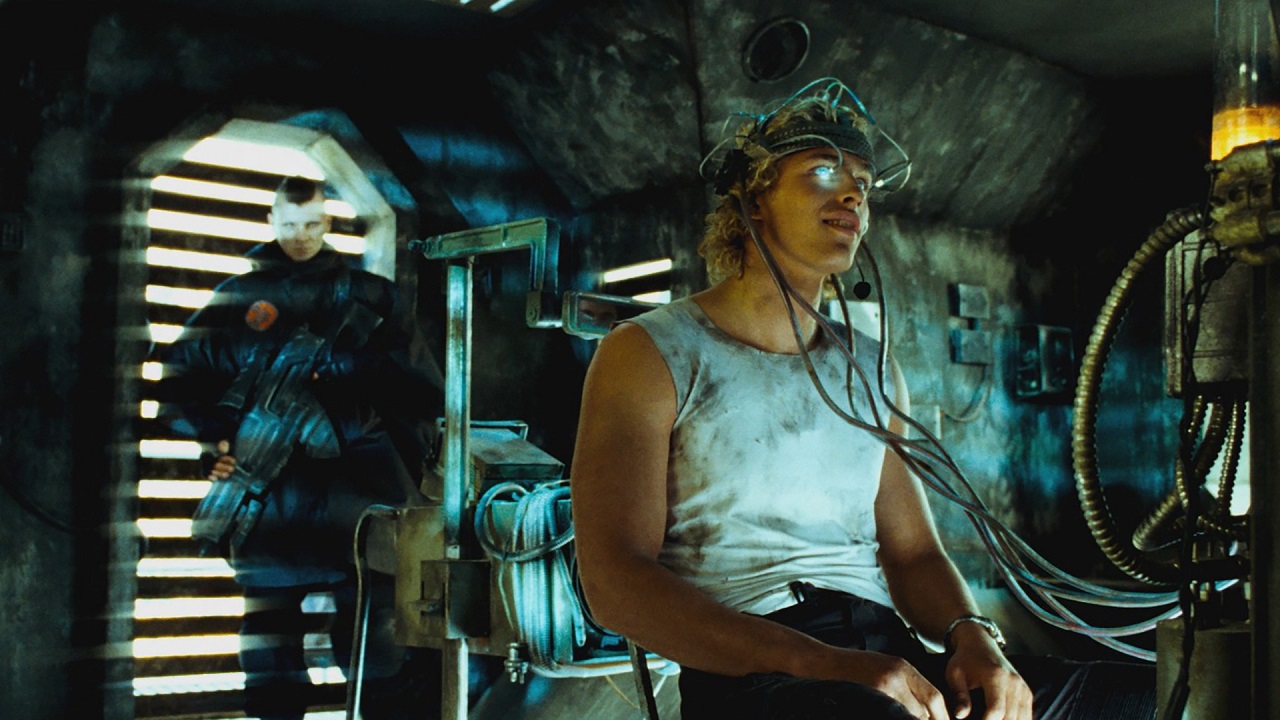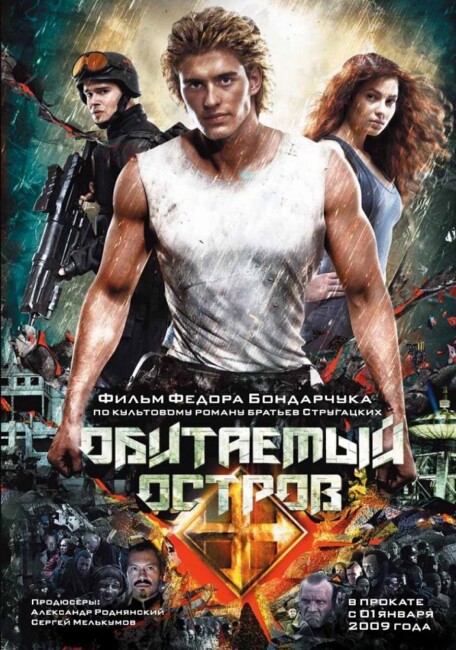aka Dark Planet
(Obitaemyy Ostrov)
Crew
Director – Fyodor Bondarchuk, Screenplay – Marina Dyachenko & Sergei Dyarchenko, Based on the Novel The Inhabited Island by Arkady Strugatsky & Boris Strugatsky, Producers – Fyodor Bondarchuk, Sergey Melkumov, Alexander Rodnyansky & Dmitry Rudovskiy, Photography – Maksim Osadchiy, Music – Yuriy Poteenko, Visual Effects – Asymmetric Effects, EyeScream Studio & Main Road Post, Creature/Makeup Effects – Quantum Creation FX, Production Design – Vladislav Nikulin, Pavel Novikov & Zhanna Pakhomova. Production Company – Art Pictures Studio/CTC Channel/Non-Stop Productions/STS Channel.
Cast
Vasiliy Stepanov (Maxim Kammerer), Yuliya Snigir (Rada Gaal), Pyotor Fyodorov (Gai Gaal), Aleksey Serebryakov (Strannik/Nomad), Sergey Garmash (Zef), Mikhail Evlanov (Captain Chacho), Gosha Kutsenko (Veper), Andrei Merzlikin (Fank), Maksim Sukhanov (Papa)
Plot
It is the year 2157 and humanity has spread out across the galaxy. Young explorer Maxim Kammerer’s ship is hit by an asteroid and crashes on a planet, blowing up just after he makes an escape. He is captured by the authorities and taken to the city but makes an escape in the midst of an attack by the degenerate rebels. He falls in with waitress Rada Gaal who offers him shelter at her apartment. He is astounded that the people of the planet lack an awareness of the rest of the universe beyond and think that they live on the inside of a sphere. Rada’s brother Gai, one of the arresting guards, befriends Maxim and recruits him to join the military. Maxim rises rapidly through the ranks but soon balks at being required to treat the degenerates with brutality and kill those he rounds up. He is sent to be executed but recovers from his wounds and joins the degenerates. He learns that the towers placed around the perimeter of the state are not missile shields as claimed but devices designed to cause intense pain to the degenerates twice per day.
The Brothers Strugatsky, Arkady and Boris, were the foremost writers of science-fiction during the era of the Soviet Union. They produced works such as Hard to Be a God (1964), Snail on the Slope (1966), The Second Martian Invasion (1967), Tale of the Troika (1968), The Dead Mountaineers’ Hotel (1970) and Roadside Picnic (1972), to name their most famous works. These were sporadically translated in the West. Their books have produced a number of film adaptations, the most famous being Andrei Tarkovsky’s loose adaptation of Roadside Picnic in Stalker (1979). (See bottom of page for their other adaptations).
Inhabited Island is a lavish production of the Strugatskys’ book The Inhabited Island/Prisoners of Power (1971). The various elements of the book – the cruelly totalitarian regime run by a clique of party bureaucrats who employ propaganda (and mind control in the book); the brutal treatment of dissenters; the dreary rundown life in the polluted cities where the populace remain ignorant of the wider world beyond – is seen as being a disguised critique of life in the Soviet Union. Even though the film version of Inhabited Island has been made nearly two decades after the fall of the Soviet Union, the allegory and characters are still preserved as though this were a straight reading. It may well say something about how broad the Strugatskys had to make their social allegory in order to get their work past Soviet censorship that their story can still stand up today and hold social relevance – the corrupt totalitarian state allegory slots in easily as another of science-fiction’s dark futures, while the military dealings with the degenerates could stand as critiques of modern Russia’s wars in Chechnya, Georgia and Ukraine or even the West’s Iraq War.
As with a good many American science-fiction films, Inhabited Island places much of the focus on production values and determines to look good. There are some lushly designed sets and great effects. The film presents a standard Cyberpunk dark future with a good deal of texture and colour. It is in these early scenes that the film holds much promise where it looks like the Russians have put effort into making a film that rivals Hollywood. Fyodor Bondarchuk also offers up revved-up action moves – alas does so about a decade after most of the rest of Hollywood discovered John Woo. At other time, Bondarchuk’s direction is overwrought – like the scene where Vasiliy Stepanov returns from war to Yuliya Snigir and their reconciliation is shown in overblown slow-motion and the ridiculously over-the-top effects of a light appearing to turn on behind them as their faces come together to kiss.

Unfortunately, despite its lineage to the Strugatskys book, there is not too much that seems to be going on in Inhabited Island in the story department. I had not read up on the book before watching the film and was unaware of the allegory it was trying to swing. I kept trying to work out where the film was going through its dogleg changes of tone as it passes through cliche treatments of a dark future, then jumps off into a military training story, before the hero joins the rebel underground. Up on screen, the film could almost be an episode of one of the modern Star Trek series – where one of the regular characters might get stranded on an alien world for the duration and come across the straw society that has been constructed. The lavish detail placed into the construction of the world drops off and the film seems to become something more along the lines of a terrestrial war film during its latter half.
There often seem to be random plot elements – for some reason, the party are attacked by an alien creature, which seems to be there for no other reason that that the action needs some spicing up, but this is never referred to again. Earlier Vasiliy Stepanov is shot point blank and makes a miraculous recovery with no explanation of why, while it is also hinted that he has powers superior to the rest of the people on the planet. Whenever the latter half seems in danger of flagging, the film throws in tanks shooting up the forest and the rebels blowing things up in an effort to make proceedings more interesting.
Of course, if you read the Strugatskys book, there is far more happening than that. However, the production has been shot as one large film and then cut in two so one is unable to see where the allegory is going from simply a viewing of Part 1. No doubt some of this may be explained when I get around to watching the sequel but on its own Inhabited Island is confusing. The problem with the film is also that while Fyodor Bondarchuk does follow the book to a reasonable degree, he does not seem that well attuned to making its ideological points. It is the film’s mistake to pitch what is a complex social allegory down more at the level of action movie happenings and spectacle-driven dark futures and space opera.
The story was continued in the second part Inhabited Island: Rebellion (2009), released four months later. Neither films were the big box-office hits their makers expected.
The Strugatsky Brothers’ books have produced a number of film adaptations, the most famous being Andrei Tarkovsky’s loose adaptation of Roadside Picnic in Stalker (1979), along with other works such as The Dead Mountaineers’ Hotel (1979), The Sorcerers (1982), Days of Eclipse (1989), Hard to Be a God (1989), The Temptation of B. (1991), and Hard to Be a God (2013), as well their having written the screenplay for the nuclear holocaust film Letters from a Dead Man (1986).


